
|
Newsletter from the Secretariat for Preparatory Activities of UNESCO-PWRI Centre (ICHARM)
Issue No.5 May 2005 | |
In this 5th issue of our periodical newsletter we continue our focus in providing our national and international partners and colleagues with our up-to-date information on the progress of the preparatory work toward the establishment of the center in the fiscal year 2005. | |
|
What's in this issue
| 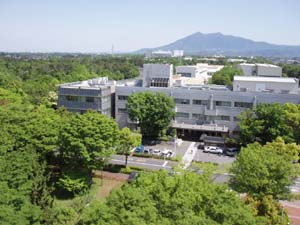 PWRI and Mt.Tsukuba (May 10 2005) |
|
1. Message from the Director | |
| The Executive Board, where the 58 UNESCO member countries discuss globally important issues, is held biannually in spring and fall in advance of the UNESCO General Conference, where all 191 member countries participate in decision-making on various matters.This past April, the 171st Executive Board discussed, among other important issues, the proposal by the Japanese government that the Public Works Research Institute (PWRI) set up and operate an international center for water hazard and risk management under the auspices of UNESCO. After examining carefully both the results of the feasibility study on the prospective center, which was conducted by the UNESCO Secretariat, and the proposed agreement on the establishment of the center, which has been coordinated by the Japanese Delegation to UNESCO, the Executive Board agreed that the proposal should be on the agenda for approval at the General Conference this comming October. At this occasion, I would like to express my utmost gratitude to all people and organizations concerned for their support from various standpoints. Also, I would like to sincerely ask for your continuous support and cooperation towards the approval of our proposal at the General Conference and the conclusion of the agreement. This past April, the Secretariat for Preparatory Activities of UNESCO-PWRI Centre started its second year. New members has joined our office in order to ensure smooth organizational management after the center's establishment as well as to enhance the secretariat work before its launch. Specifically, the Hydrologic Engineering Research Team with Mr. Fukami as a team leader, previously belonged to the Hydraulic Engineering Research Group, became part of the Secretariat of the Centre. Together with the Risk Management Research Team with Mr. Yoshitani as a team leader, there are now two research teams in the Secretariat. Mr. Tanaka is in charge of a special mission on planning and coordinating training activities including Tsunami Disaster Prevention. With our new members and fresh organizational structures for this new fiscal year, we will make our best effort towards the establishment of the Centre. | |
|
| |
| 2. Recent Topics | |
|
i. International Workshop on Flash Flood Disaster Mitigation in Asia "Flash Flood" is a type of flood caused by a volume of water in a brief time(generally in 6 hours, definition by NOAA). Asia monsoon area suffers from not only seasonal floods but also flash floods, and it is not unusual to experience flood disasters with more than hundreds of casualties. Moreover, in recent years, it is said that flash floods have shown a tendency to increase in number and intensity, there are emerging needs to evaluate current trends and mitigation approaches for flash floods. We invited specialists from Asian countries and held "International Workshop on Flash Flood Disaster Mitigation in Asia" (March 2-4). This workshop was partially funded by the MEXT research program, "Leadership for International Scientific Cooperation: Leadership on the Hydrological Science for Mitigating World Water Issues" (Project Leader: Associate Prof. Taikan Oki, Institute of Industrial Science, University of Tokyo), under the special coordination funds for promoting science and technology. There were three main objectives for this workshop: 1) To understand actual situations of flash flood disasters and preventive measures for reducing them; 2) To share information on state-of-the-art technologies to monitor, forecast and analyze flash floods; 3) To discuss what kind of approaches should be taken further in the near future in order to mitigate flash flood". PWRI invited specialists from China, Korea, the Philippines, Thailand, Malaysia, Bangladesh and Costa Rica. on the basis of Dr. Grabs, Chief of the Water Resources Division of the World Meteorological Organization (WMO), also joined the workshop. Each specialist presented current situations and mitigation approaches against floods in each country, and participants actively discussed emerging approaches that should be taken for flash flood mitigation the near future. In that discussion, it was confirmed that we had not yet developed forecasting techniques which could predict floods accurately under various natural and social conditions. It was also confirmed that it was important to improve the accuracy of precipitation forecast and develop technologies which could establish flood forecasting systems capable to function under various conditions. It was concluded that the accuracy of flood forecasting was limited at present, and thus, comprehensive approaches that included structural and non-structural measures were necessary for flash flood mitigation.
| |
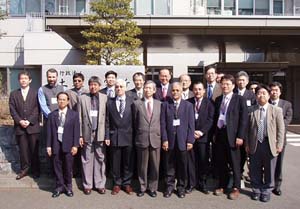 In front of PWRI main building |
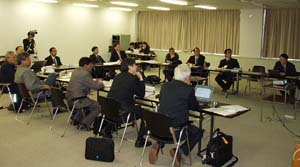 Workshop meeting continued for 3 days |
|
ii. Construction Progress of the Office Building of UNESCO-PWRI Centre The construction of the office building of UNESCO-PWRI Centre, located on the north side of the PWRI main building, has been progressing steadily since the start in August 2004. Reconstructing an engineering laboratory complex, construction is half way done (all the external and roofing work was finished this past March). (See photo). Interior work, including partitioning rooms and installing administrative/research facilities, is undergoing. The entire building facilities are planned to be almost completed in September 2005. | |
 Outside of UNESCO-PWRI Centre |
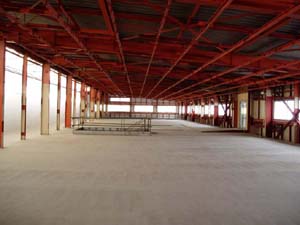 Inside of UNESCO-PWRI Centre (under construction) |
|
iii. Installation of Rainfall Gauges in Cambodia Research Revolution 2002-(6): As a part of the development of a water resource prediction model, titled "Model Development to Assess the Change of Water Resources Due to Human and Natural Changes in Asia Monsoon Region" (Project Leader: Prof Kuniyoshi Takeuchi, University of Yamanashi), Mr. Inomata and Mr.Amou went to Cambodia from the 23rd to 29th of March. The purpose of this business trip was to install rainfall gauges in Cambodia. The Tonle Sap Lake, located in the midwestern part of Cambodia, is the largest freshwater lake in Indochina. In the rainy season, the water level of the Mekong River rises and flows in large amount into the Tonle Sap Lake. Because the lake stores a large volume of water from the Mekong River, the water surface area expands tremendously three or four times of that in the dry season. The Tonle Sap Lake is natural retarding basin that contributes to the flood safety of the Phnom Penh, capital of Cambodia. Presently, our research team is conducting research to reconstruct past hydrologic data and clarify the functionality of the Tonle Sap Lake as a flood retarding lake in the past 20 years. We are focusing on the Pursat River Basin in the southwest of the Tonle Sap Lake, a major tributary, to estimate water balance of the lake basin. | |
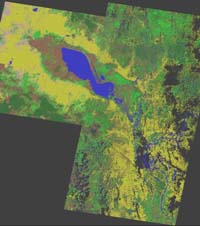 Tonle Sap Lake in Dry Season |
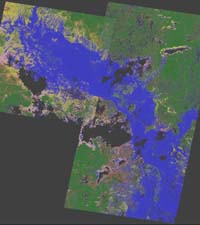 Tonle Sap Lake in Rainy Season |
| We installed six rainfall gauges in the Pursat River Basin. The installation was carried out with local collaboraters. Our research team held technical lecture related to the installaton, functionality and data collections. We hope that these achievements will contribute to the development of an observation network in Cambodia. In the near future, our plan is to teach how to maintain the rainfall network gauges. |
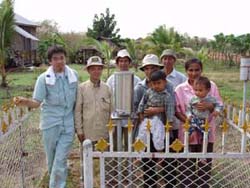 Installed Rainfall Gauge (Center), Researcher Mr. Amou (Left) and Local Collaboraters |
|
iv.
Publication of the English Version of "Dr. Isami Hiroi: The Life
of a Japanese Christian Civil Engineer" Ms. Aiko Asukai, the fourth direct descendent of Dr. Hiroi translated this book into English. The english title of the book reflects Ms. Asukai's wish as to be simple enough for foreign readers to understand its massage right away. After her translation work, Ms. Asukai commented that she was "more proud of Dr. Isami Hiroi because of his vigorous efforts in learning Western thoughts and knowledges. He was a pioneer in Japan's civil engineering and helped many to become excellent experts in the field." We plan to give copies of the book to participants in international conferences and researchers visiting PWRI both from within Japan and the rest of the world to serve training human resouces in developing countries and to introduce Japanese civil engineering technology. Since these books are not sold at bookstores, please contact the address at the very end of this newsletter if you would like to buy a copy. Getting a copy costs 1,000 yen (including tax) plus the shipping charge.
| |
|
3. Reports on Recent Conferences Attended | |
|
IFI will implement research, education and training, information
networking, human networking for good governance and technical assistance according
to the five fundamental guidelines; "Living with Floods," "Interdisciplinary,"
"Empowered Participation," "Trans-sectionality" and "International
and Regional Cooperation." At this meeting, the taskforce members confirmed
and revised the above-mentioned concepts and made an initial implementation plan
for each theme such as "Vulnerability," "Flood Risk Assessment,"
"Governance and Public Participation," "People-centered Early Warning
and Emergency Management." | |
|
| |
|
iii. 171st UNESCO Executive Board on April 21st-26th,
2005 | |
| 4. Research on Chao Phraya River Basin, Kingdom of Thailand | |
| Taichi TEBAKARI JST/CREST Project Research Fellow
This study proposes system models for assessing the effects of social changes on hydrological cycles in river watersheds as well as water movement and balance especially among Asian countries, which are expected to be developing dynamically in terms of population and economic growth, industrial transfer and urbanization, while Japan is expected to continue in a stable developed stage. The models aim at quantitative assessment of the interactions between meteorological-hydrological dynamics and social dynamism, and also of the availability and risk of freshwater resources in Asia. Also discussed are Japan's future water resources policies in connection with food and industrial policies and strategic perspectives on how to contribute in solving similar problems in the world. As mentioned above, I intended to use the Chao Phraya River basin in Thailand as a case study. The Chao Phraya River basin, the largest basin in the Kingdom of Thailand, is located in the central and northern part of Thailand. This basin has two large-scale dams: the Bhumibol Dam on the Ping River and the Sirikit Dam on the Nan River. These large reservoirs have contributed to the economic development of the country by meeting increasing electric and irrigation demands as well as to flood mitigation in the riparian areas along the Ping, the Nan and the Chao Phraya Rivers. The
following is part of the results obtained: The spectrum of flow was analyzed by using FFT for daily discharges in Nakhon Sawan and immediately downstream of the Bhumibol Dam (Royal Irrigation Department's code P.12) after the Bhumibol Dam construction. The flow in Nakhon Sawan has the periodic characteristics of 3.5 days and 7 days, and the released water from the Bhumibol Dam at P.12 has the periodic characteristics of 2.5 days, 3.5 days and 7 days. The reservoir operations affected the hydrological cycles considerably. Finally, the two large-scale dams promote irrigation in the middle and the lower Chao Phraya River basin during the dry season and improve agricultural production quantity. There has been a considerable stabilization of agricultural production. Moreover, the utility form of water-use also has greatly changed. It is not possible to absolutely disregard the effect of large-scale human activities, such as the large-scale dam construction, on water circulation. It can be clearly seen that a holistic understanding of human activities in correlation with runoff and hydrological models is indispensable. | |
|
5. International Meetings | |
| During the period from June to mid September 2005, representatives from our secretariat are planned to attend future international meetings. | |
|
This Forum is organized to establish both the integrated management of water resources
and local activities for the effective promotion of governance. One of the themes
for this coming conference is "Water, Environment, Ecosystem, Integrated
Coastal Areas, and Water Related to Natural Disasters/Climate Changes." Under
this theme, there will be presentations on case-study programs and discussions
specifically about effective action plans based on the results of those programs.
XXXI Congress of IAHR http://www.iahr2005.or.kr/ [September
9-10 Korea, Seoul] The International Association of Hydraulic Engineering and Research (IAHR) is a worldwide independent organization of engineers and water specialists working in fields related to hydraulics and its practical application. Over 1000 professional usually participate in this congress to exchange the latest researches and discuss newest technologies. There will be 8 special seminars & workshops prepared in the 31st congress. A representative from the Secretariat is planning to make presentation in SS-6 named "Coping with Risk" organized by UNESCAP and Typhoon Committee Hydrological Component.
| |
|
URL:
http://www.unesco.pwri.go.jp/ | |
Copyright (c) 2008 Public Works Research Institute
|

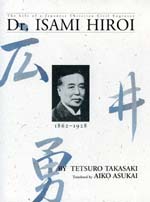 As a part
of the preparatory activities to set up the UNESCO-PWRI Centre, we compiled the
English version of "Dr. Isami Hiroi: The Life of a Japanese Christian Civil
Engineer" published by Kajima Institute Publishing Co., Ltd., written in
Japanese by Mr. Tetsuro Takasaki, guest researcher of PWRI.
As a part
of the preparatory activities to set up the UNESCO-PWRI Centre, we compiled the
English version of "Dr. Isami Hiroi: The Life of a Japanese Christian Civil
Engineer" published by Kajima Institute Publishing Co., Ltd., written in
Japanese by Mr. Tetsuro Takasaki, guest researcher of PWRI. 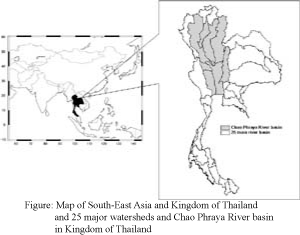 This
study is partially funded by the Core Research for Evolutional Science and Technology
(CREST) Program under
This
study is partially funded by the Core Research for Evolutional Science and Technology
(CREST) Program under